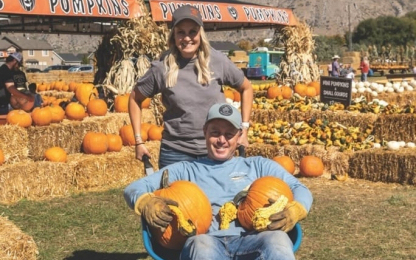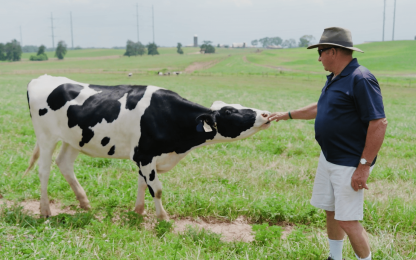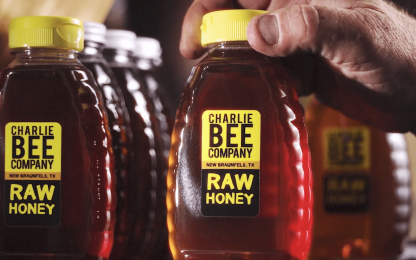It has long been said that farmers are gamblers due to forces of nature and marketplace swings each year. As pecan growers, the Spradlings’ couldn’t agree with that statement more.
If you have driven east of Tulsa on Interstate 44, you have probably seen Mike and Lotsee Spradling’s pecan orchard. Most of the orchard sprawls along the west side of the turnpike as it crosses over the McClellan-Kerr Arkansas River Navigation System.
Mike recalled purchasing the original orchard in 1986. He bought the 200-acre property in lieu of foreclosure with a balloon payment to afford him time to secure permanent financing. Harvest the first year was completed without Mike having an expense in the crop or having permanent financing secured. Today, Flying G Ranch Pecans spans 600 owned acres and 200 leased acres – with a long- term fixed-rate from Oklahoma AgCredit’s Broken Arrow office.
Water Wranglers
With the right amount of water, many pecan tree varieties grow faster and produce nuts nearly twice the size of nuts on non-irrigated trees. With that motivation, Mike launched an irrigation project in partnership with USDA through the Environmental Quality Incentives Program (EQUIP), which provides financial and technical assistance to producers to help plan and implement conservation practices that address natural resource concerns. The program helps with opportunities to improve soil, water, plant, animal, and air resources on agricultural property. Mike also had to secure a 20-foot easement to the navigation channel from the Corp of Engineers.
Following stringent restrictions, Mike and his three employees installed the irrigation system in phases. “It was quite the engineering feat for a bunch of cowboys,” Mike said.
A cistern, tank and pump were connected in 2016 to transport water from the navigation channel to over a mile of pipe extended through the orchard. The pump delivers water from the bottom of the channel into a disk filter to remove impurities. Nutrients are delivered to trees through an injection system. Irrigation has been good for Mike and for the trees. Automating some parts of the system has allowed staff more time to perform other work. Many pecan varieties benefit from getting just the right amount of water, right when they need it. In most circumstances, the native pecan trees are not irrigated.
Soil moisture is measured every four inches at a depth of 48 inches to monitor when irrigation needs to be utilized. Water is delivered to the trees by Nelson R10 rotators at a rate of three gallons per hour. Irrigation has benefits other than providing water. During times of late spring or early fall freezes, water can be used to raise the air temperature to prevent possible freeze damage. Pecan damage can occur at 25-27 degrees when exposed to these temperatures for as little as three hours.
Love Hurts
Ask Mike what the most difficult task is at the orchard. He’ll tell you it is thinning the orchard by trimming or removing trees. After all the time spent to care for trees, deciding to significantly hedge or remove a tree can be tough. It can also be labor-intensive work. The perfect tree spacing in a pecan orchard is 50% sunlight, 50% shade at high noon. If amounts of sun and shade surrounding the tree are not equal, it needs a haircut.
Very large, old trees are removed based on two factors – condition of the tree and location relative to other trees. This achieves important requirements for pecan production: moisture, nutrients, airflow and sunlight penetration. Some of the native pecan trees in Mike’s orchard were producing pecans over 100 years ago.
Top-performing trees need sunlight exposure on all sides. This is accomplished by trimming adjacent trees and by removing unhealthy or crowding trees. These tasks are done by using a Sky Trim, dozer, and excavator.
Thinning nuts helps increase pecan production. Mike wants nuts on 60 percent of the tree. By shaking trees in August, nut clusters are reduced and the remaining clusters have a better chance to fully develop pecans. Mike utilized Oklahoma AgCredit’s equipment financing program, AgDirect, to purchase several of the machines used in the orchard.
Pecan Tree Bandits
Like any farmer, Mike has to fend off unwanted visitors to the orchard. In August, weevil traps are attached to trees in the orchard to monitor weevil populations. The circle trap looks like an upside-down minnow trap; weevils climb in but can’t get out. Shields have to be secured around little trees or deer will eat the tops off or bucks scrape bark off with their antlers. Each squirrel can consume 50 pounds of pecans per year and a crow can consume 45 pounds. Pecan scab, a fungal infection, on leaves and young stems must be monitored. It can be managed by removing orchard floor debris, pruning and fungicide. It is the most economically important pecan disease for Oklahoma, according to the Noble Research Institute.
Lasting Legacy
Careful planning, proper management and investments to improve production have been slowly realized over the years. The orchard is now made up of 60% native and 40% papershells.
“The most important management tool of any pecan orchard is the grower’s shadow on the orchard floor,” Mike said. “Commercial pecan production is highly labor-intensive and requires frequent involvement.”
Mike is part of the American Pecan Council, representing large pecan growers in the central region. The Council is responsible for oversight of the federal pecan marketing order.
Whether it be producing pecans or other agricultural endeavors, Mike’s philosophy for achievement is this, “The success of any endeavor depends upon the amount of one’s involvement. Things don’t just happen, people make things happen.”
He grinned as he thought about his grandchildren taking over the operation one day, “The neat thing about pecans versus other crops is that several generations later, my great-grandkids can look down the orchard and say ‘old dough boy wasn’t so dumb after all.’”



